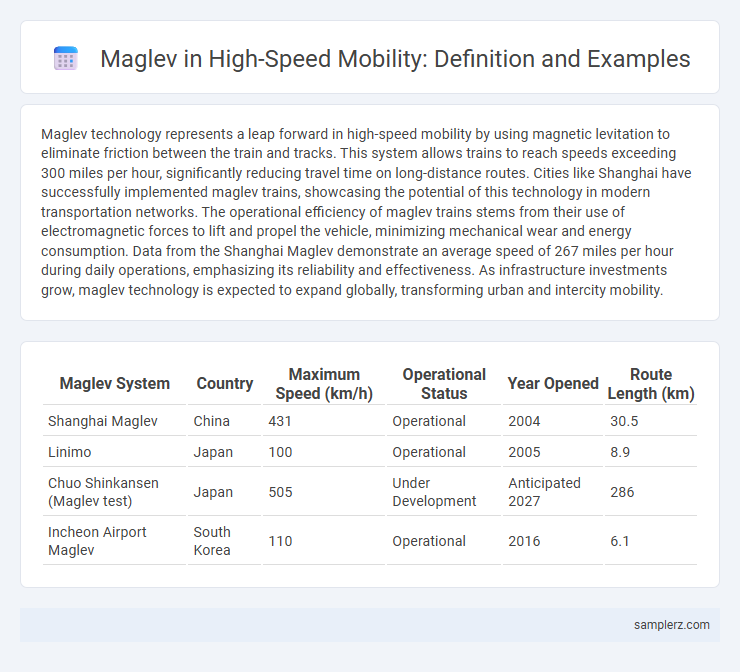Maglev technology represents a leap forward in high-speed mobility by using magnetic levitation to eliminate friction between the train and tracks. This system allows trains to reach speeds exceeding 300 miles per hour, significantly reducing travel time on long-distance routes. Cities like Shanghai have successfully implemented maglev trains, showcasing the potential of this technology in modern transportation networks. The operational efficiency of maglev trains stems from their use of electromagnetic forces to lift and propel the vehicle, minimizing mechanical wear and energy consumption. Data from the Shanghai Maglev demonstrate an average speed of 267 miles per hour during daily operations, emphasizing its reliability and effectiveness. As infrastructure investments grow, maglev technology is expected to expand globally, transforming urban and intercity mobility.
Table of Comparison
| Maglev System | Country | Maximum Speed (km/h) | Operational Status | Year Opened | Route Length (km) |
|---|---|---|---|---|---|
| Shanghai Maglev | China | 431 | Operational | 2004 | 30.5 |
| Linimo | Japan | 100 | Operational | 2005 | 8.9 |
| Chuo Shinkansen (Maglev test) | Japan | 505 | Under Development | Anticipated 2027 | 286 |
| Incheon Airport Maglev | South Korea | 110 | Operational | 2016 | 6.1 |
Overview of Maglev Technology in High-Speed Mobility
Maglev technology utilizes magnetic levitation to eliminate friction between the train and tracks, enabling speeds exceeding 600 km/h for high-speed mobility. This system employs powerful electromagnets for both lift and propulsion, resulting in a quieter, smoother, and more energy-efficient travel experience compared to conventional rail. Key examples include the Shanghai Maglev Train and Japan's SCMaglev, which demonstrate the potential of maglev in revolutionizing high-speed transportation infrastructure worldwide.
Key Principles Behind Maglev High-Speed Systems
Maglev high-speed systems leverage electromagnetic suspension (EMS) or electrodynamic suspension (EDS) to achieve frictionless travel by levitating the train above the track. Key principles include magnetic attraction and repulsion forces that stabilize and propel the vehicle at speeds exceeding 600 km/h, reducing maintenance costs and energy consumption. The lack of physical contact minimizes noise and vibration, enabling ultra-smooth and efficient urban and intercity transport solutions.
World’s First High-Speed Maglev Example: The Shanghai Maglev
The Shanghai Maglev represents the world's first high-speed maglev train, reaching speeds up to 431 km/h (268 mph) during commercial operation. Covering a 30.5 km (19-mile) distance between Shanghai Pudong International Airport and Longyang Road Station in just 7 minutes, it showcases the potential of magnetic levitation technology for rapid transit. This pioneering project highlights the integration of maglev systems in urban mobility, reducing travel time and promoting sustainable transportation solutions.
Japan’s Chuo Shinkansen: Next-Generation Maglev High-Speed Rail
Japan's Chuo Shinkansen, a cutting-edge maglev project, aims to connect Tokyo and Nagoya with speeds reaching 500 km/h, significantly reducing travel time to about 40 minutes. Utilizing superconducting maglev technology, it eliminates friction, enabling ultra-high speed and smooth acceleration. The project exemplifies advancements in magnetic levitation, setting new standards for future high-speed rail systems globally.
The South Korean Maglev: Urban High-Speed Integration
The South Korean Maglev system exemplifies urban high-speed integration by seamlessly connecting major metropolitan areas with advanced magnetic levitation technology that reduces travel time and enhances commuter experience. Capable of reaching speeds over 100 km/h, this maglev line supports sustainable urban mobility by minimizing noise and electromagnetic emissions compared to conventional trains. Its deployment demonstrates South Korea's commitment to cutting-edge transportation infrastructure, promoting efficient transit solutions in densely populated regions.
Germany’s Transrapid: Pioneering Maglev Applications
Germany's Transrapid system exemplifies pioneering maglev technology in high-speed rail, achieving operational speeds exceeding 500 km/h. Utilizing electromagnetic suspension and propulsion, Transrapid eliminates wheel-rail friction, enabling smooth and efficient transit. Its successful integration in the Shanghai Maglev Train showcases Germany's leadership in advancing maglev mobility solutions.
Prospective Maglev Projects: Mobility Visions in Europe and the US
Prospective maglev projects in Europe and the US aim to revolutionize high-speed mobility by drastically reducing travel times and enhancing energy efficiency compared to conventional rail systems. The European Union's Transrapid initiatives and the US magnetically levitated train proposals emphasize low maintenance costs, minimal environmental impact, and seamless integration with existing transportation networks. Key developments include planned maglev corridors linking major metropolitan hubs, promising speeds exceeding 600 km/h and transformative urban connectivity.
Safety Standards and Operational Reliability in High-Speed Maglevs
High-speed maglev trains, like the Shanghai Maglev, adhere to rigorous safety standards ensuring collision avoidance through advanced sensor networks and real-time monitoring systems. Operational reliability is maintained by redundant components and automated control algorithms that minimize human error and system failures. These safety protocols result in an average operational availability exceeding 99%, setting benchmarks for the future of high-speed rail transit.
Environmental Impact of High-Speed Maglev Systems
High-speed maglev systems produce significantly lower carbon emissions compared to traditional rail and air travel due to their reliance on electric propulsion and reduced friction, which leads to increased energy efficiency. The lack of direct contact between train and track minimizes noise pollution, offering a quieter alternative for densely populated areas. Moreover, maglev technology supports the use of renewable energy sources, further enhancing its environmental sustainability profile in the mobility sector.
Future Implications of Maglev for Sustainable High-Speed Mobility
Maglev technology offers transformative potential for sustainable high-speed mobility by drastically reducing friction and energy consumption compared to traditional rail systems. Its ability to achieve speeds exceeding 600 km/h while maintaining low carbon emissions positions maglev as a critical solution for future urban transit and intercity travel. Investing in maglev infrastructure supports the transition toward environmentally friendly transport networks, enhancing efficiency and reducing reliance on fossil fuels.

example of maglev in high-speed Infographic
 samplerz.com
samplerz.com